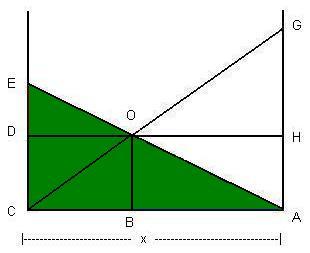|
|
Crossing
Ladders
|
|
|
Step 2: Ratio of AC and DEThere are many websites that explain the proof and explanation of the Pythagorean Theorem, so they will not be described here. Instead, we shall continue with the solution to the Crossing Ladders Problem and find the ratio between AC and DE. Triangle AECConsider the triangle AEC:
According to the Pythagorean Theorem, the square of the hypotenuse equals the square of the base plus the square of the height. In the triangle AEC above:
We know that the value of the line AE is 20, and we can substitute:
and simplify:
By looking at the diagram above, we notice that the line CE is comprised of the line CD plus the line DE, so be can substitute, in place of CE2 , the value (CD + DE)2 as follows:
Notice that the value of line CD is the same as the value of line OB, and we know that line OB equals 5. Thus we can substitute for CD with this value:
Further simplifying:
Simplifying again, we derive the fourth basic equation and complete Step 2 of the solution:
|
|
